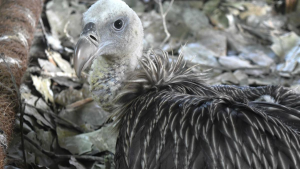Context:
Recently, the Assam State Zoo in Guwahati has achieved a groundbreaking feat by successfully breeding the elusive Himalayan vulture (Gyps himalayensis) in captivity for the first time in India.

Relevance:
GS III: Environment and Ecology
Dimensions of the Article:
- Exploring the Himalayan Vulture
- Ketoprofen and Aceclofenac: Impact on Vultures
Exploring the Himalayan Vulture
Conservation Status:
- IUCN Red List: Near Threatened.
- CITES Appendix II.
Impressive Characteristics:
- Stature and Wingspan: Among the largest Old World vulture species, boasts an imposing wingspan and formidable presence.
- Camouflaged Plumage: Adorned with shades of black and brown, aiding in seamless blending with rugged mountain landscapes.
- Mastery of Scavenging: Possesses a powerful hooked beak and keen eyesight, excelling as an efficient scavenger, vital for carrion clean-up.
Habitat and Range:
- Himalayan Haven: Primarily found in the towering peaks and valleys of the Himalayan mountain range.
- Winter Migration: Commonly migrates to the Indian plains during the winter season.
- Extensive Range: Thrives across countries like India, Nepal, Bhutan, and China, adapting to challenging high-altitude settings.
Ecosystem Role:
- Ecological Cleaner: Serves as a crucial top predator and scavenger, maintaining habitat health by disposing of animal remains.
- Disease Prevention: Acts as a shield against disease spread from decaying carcasses, contributing to ecosystem balance.
Captive Breeding Challenges and Success:
- Snowy Breeding Habits: Natural breeding in snow-clad mountains posed captivity challenges.
- Acclimatization Triumph: Successful zoo breeding via long-term captivity and acclimatization to tropical conditions.
Threats and Conservation Efforts:
- Vulnerability Factors: Habitat loss, food scarcity, and accidental poisoning from veterinary drugs contribute to its vulnerable status.
- Conservation Breeding Centers: Vital role played by centers like the Vulture Conservation Breeding Centre (VCBC) in Rani, Assam, in safeguarding this vulture species.
Ketoprofen and Aceclofenac: Impact on Vultures
Ketoprofen and Aceclofenac: NSAIDs for Pain and Inflammation:
- Ketoprofen and aceclofenac are non-steroidal anti-inflammatory drugs (NSAIDs) commonly used to alleviate pain and reduce inflammation in animals, particularly cattle.
- These drugs are prescribed for various conditions including arthritis, injuries, and post-surgery pain management.
Harmful Effects on Vultures:
- Lethal Consequences: These NSAIDs have proven to be detrimental to vultures, leading to severe health consequences and even death.
- Kidney Failure: Consumption of animal carcasses treated with ketoprofen or aceclofenac results in kidney failure among vultures.
- Carcass Contamination: Vultures feeding on treated animal remains ingest the drugs, which wreak havoc on their renal system, ultimately causing fatal damage.
Ecological Impact:
- Ecosystem Disruption: The decline in vulture populations due to NSAID toxicity disrupts the ecological balance, as vultures play a crucial role in scavenging carcasses and preventing the spread of diseases.
- Carrion Cleanup: Vultures’ natural scavenging behavior contributes to the removal of carcasses, thus reducing the risk of diseases that could arise from decaying animal remains.
Conservation Concerns and Measures:
- Drastic Decline: The toxic effects of these NSAIDs have significantly contributed to the decline of vulture populations in certain regions.
- Conservation Initiatives: Awareness campaigns, changes in veterinary practices, and efforts to limit the use of these harmful drugs in livestock have been implemented to mitigate the impact on vultures.
- Vulture Safe Zones: Establishing designated areas where safe food sources are available can help safeguard vultures from the dangers of NSAID-contaminated carcasses.
Importance of Vulture Conservation:
- Environmental Balance: Vultures’ role in carrion disposal prevents the spread of diseases and contributes to a healthier ecosystem.
- Biodiversity Protection: Ensuring vulture survival is crucial for maintaining biodiversity and preventing imbalances in the food chain.
-Source: The Hindu



